We met with London-artist Mefio whose practice adds a significant contribution to the language of geometric abstraction by exploring colour depth and light and shadow effects beyond two-dimensional composition. In this conversation, the artist discusses the subjects that inspire her work, dwelling on her specific use of mediums and techniques. Mefio is represented in Italy by FineArtX (www.fineartx.com).
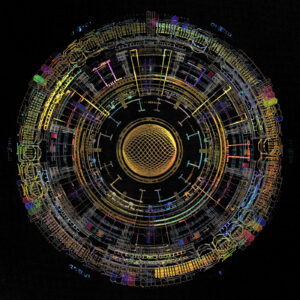
Mefio, Trius, 2021, polychromatic overlay on invisible glass, exclusive to FineArtX, courtesy of the artist
Sara Buoso: Would you like perhaps, to introduce your work by addressing three key-words that define your practice?
Mefio: If I were to describe my practice in three key words, they would be Metallic Film Overlay. In my work, I dive into the realm of overlaid metallic, polychromatic and monochromatic films on invisible shatterproof glass. This technique involves a bespoke combination of gilding, decals, foiling, and carefully applied glass. Usually, the glass is very reflective medium but this unique trending technique allows to focus on the subject rather than reflection per se. The films are glazed with a special medium that allows for the interference of light waves as they pass through the layers of the material, creating iridescence effects. In scientific terms, it’s goniochromatic phenomenon. It’s an interesting process which I developed myself when I was studying a model making course back in 2004 and still enjoy exploring.
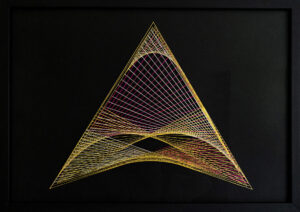
Mefio, Arrichi, 2021, polychromatic overlay on invisible glass, courtesy of the artist
Your practice sits within the long tradition of geometric abstraction, but at the same time, you’re suggesting new connotations to it. Would you like to elaborate on this?
The geometric abstraction is a language that I use ever since I started my Mefio studio. I studied model making where I felt in love with three dimensional geometry because we were learning to construct computational models by using a mathematical logarithm to create different geometries. The root is basically rooted deeply into kind of like playing with reality, what we see and what we actually can create ourselves, whether it’s two dimensional and three dimensional. Choosing this particular language allows me to create abstract works that showcase the elegance of geometric shapes and forms. For me, geometry offers a sense of order and balance. Since 2017, in my artistic journey, I have a flare for glass for its clarity and caustics. I also enjoy working with other mediums such as resin which closely resembles a liquid glass. All these elements let me push the boundaries of geometric abstraction and create new sculptural pieces or, as I call them, mixed media assemblages..
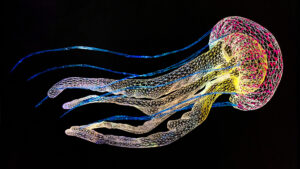
Mefio, Jellyfish, 2021, polychromatic overlay on invisible glass, exclusive to FineArtX, courtesy of the artist
Beyond this composition, your work explores the relationship between light and colour.
I experiment with specific materials and delve into the exploration of luminosity over colour, which adds an interesting contribution to these geometric abstractions. By pushing these boundaries, I want to create an engaging composition. Specifically, I work with metallic films which are composed of precious metals like silver, copper, gold, titanium and metal oxides, and these films have a remarkable ability to reflect and refract light. These films are a special blend of different metals and they have a shimmering effect to it which allow me to play with an array of colours. The films are carefully applied by hand in small elements onto a glass surface and this enhance their luminosity. What your eyes see is a shimmering iridiscent effect which adds movement, depth and dimension to the artworks. My artworks are presented on a black backdrop which is designed to add more dramatic effect to the visible colour and by investigating the luminosity of the films and the interplay with light and geometric abstraction, I aim to bring a new perspective to the world of art.
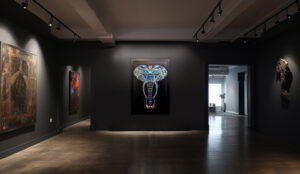
Mefio, Slon, 2023, polychromatic overlay on invisible glass, courtesy of the artist
I saw your new work Slon, 2023, which very much captured me for its majesty as well as for its fragility.
The painting Slon is a brand new artwork which I finished two weeks ago. With this work, I wanted to capture the ethereal beauty of animal because for me, animal Kingdom, it’s so fascinating and it’s one of the biggest inspirations for my work. There’s a lot of abundance of amazing and colourful creatures on Earth, whether it’s on watering or land, and the elephant. I am also fascinated by the symbolism of this figure because sometimes it goes unnoticed. I wanted to capture the importance of these animals in a very vivid sense and that’s why I decided to incorporate resin into this glass. In this sense, the elephant is not only represented in two dimensions, but when you look at it, you can see the crown, you can look at it from a few different angles where all these elements stand out. Very similar are the painting Jellyfish and Ara Macao. I chose to paint these animals because they present a beauty whatever it is in water or air, which is a beauty of colours and luminosity. Lastly, I am glad you mentioned the fragility of it because the metallic films are extremely fine and that’s one of the reasons why I use very fine lines to showcase the fine details of the work..
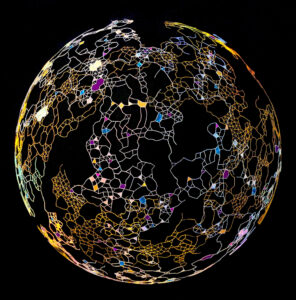
Mefio, Talla, 202, polychromatic overlay on invisible glass, Finalist at the Art Revolution Competition Taipen, courtesy of the artist
Symbolism also emerges in other works of yours, works that relate to the underworld in the junghian sense, I would say… Would you like to continue by talking about one work that is particularly meaningful to you?
Perhaps you’re referring to artwork called Talla. This piece was currently exhibited in Taipei in the Art Revolution exhibition where I had a really good response from curators and exhibitors. This particular piece represents a celestial sphere, like earth. It resembles terrestrial terrains in form of a simple triangular geometry, but because it’s spherical and all of its compositions are carefully constructed, it gives you the feeling of balance as for the yin yang. One of my other most favourite pieces is titled Mille, 2022. It is composed of a cube which is shattered into a smaller fragmented cubes. I created this cube with a slight decay, so each cube is basically offset from each other and decayed to became smaller as it constructs a whole three dimensional cube piece. And this piece caught attention at the Taipei Art exhibition. Curators, collectors, and the visitors appreciated this new trending geometry because of the dimensionality of it. So that is one piece I really, really like. By contrast, Arricchi, 2022, is one of paintings that I was sad to send off because I had an emotional attachment to it through the process. I like the details. I’m perfectionist because in model making we were taught to be precise and patient, and this work is basically a very fine line constructed on a glass to create several areas. All in all, in my work, I want to create a balance and harmony through the language of patterns, proportions and symmetry. I also study the spatial relationships in my subjects because I enjoy exploring reality through perception and consciousness?
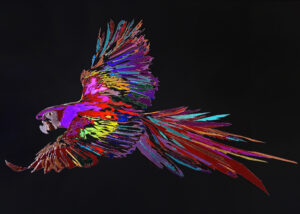
Mefio, Ara Macao, 2022, polychromatic overlay on invisible glass, exclusive to FineArtX, courtesy of the artist
Which artists from this tradition mostly inspired your work?
I find inspiration in various artists from the tradition of glass making and geometric abstraction, particularly those with Slovakian and Czech backgrounds, given my own Slovakian roots. Artists like Jiří Liška, a Czech artist known for its sharp edges, perfect surfaces, and colour transitions. Also Štěpán Pala That being said, I believe inspiration can come from many sources. I am constantly inspired by everything I see around me. Whether it is the textures, colours, or compositions, I try to absorb the world’s natural geometry. It is fascinating to recognize the repeating mathematical sequences present in our surroundings such as Fibonacci and golden ratios. When it comes to my artistic perspective embracing the polarities between nature and abstraction, I aim to create artworks that reflect the elegance of occurring geometric phenomena.
Are you currently focused on a particular project? What’s the next step in your career?
I am studying a Master Degree at East London University where I try to explore more conceptual and sculptural works as more assemblages. I want to expand my practice from a two dimensional perspective to reach a three dimensional one. I like to work with large pieces so scaling up is my point of interest now. I really enjoy learning to cut glass, bendy, and shape it because at the end, my work is very much technically driven.
Info:

She is interested in the visual, verbal and textual aspects of the Modern Contemporary Arts. From historical-artistic studies at the Cà Foscari University, Venice, she has specialized in teaching and curatorial practice at the IED, Rome, and Christie’s London. The field of her research activity focuses on the theme of Light from the 1950s to current times, ontologically considering artistic, phenomenological and visual innovation aspects.






NO COMMENT